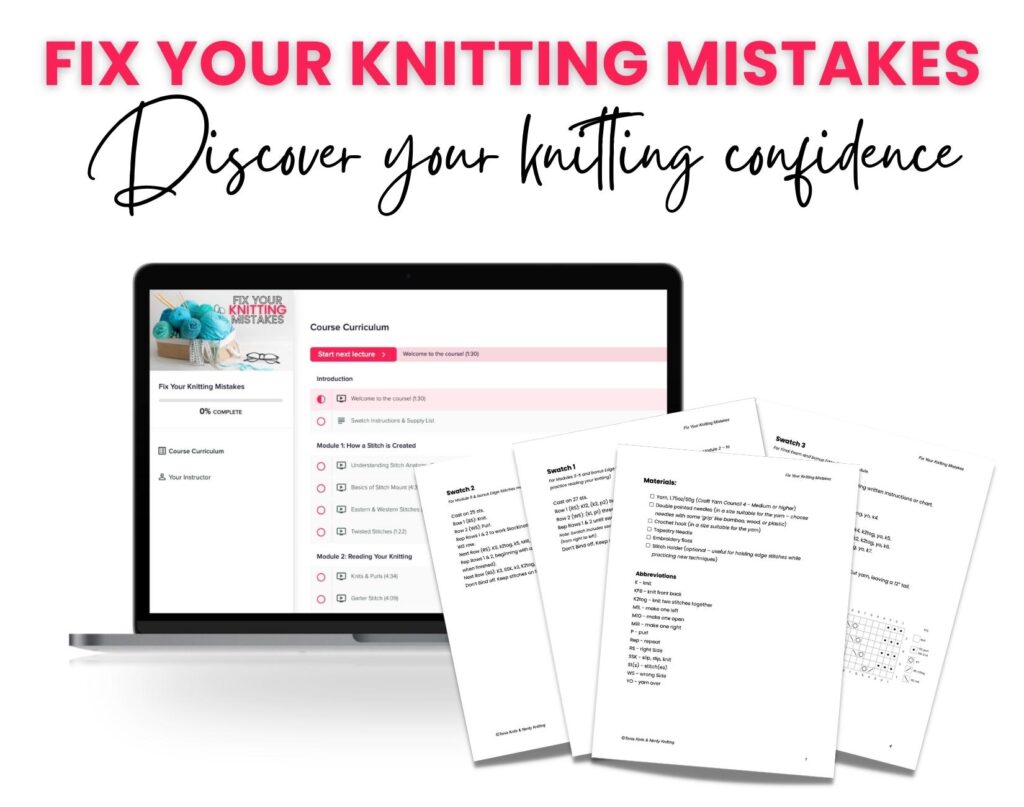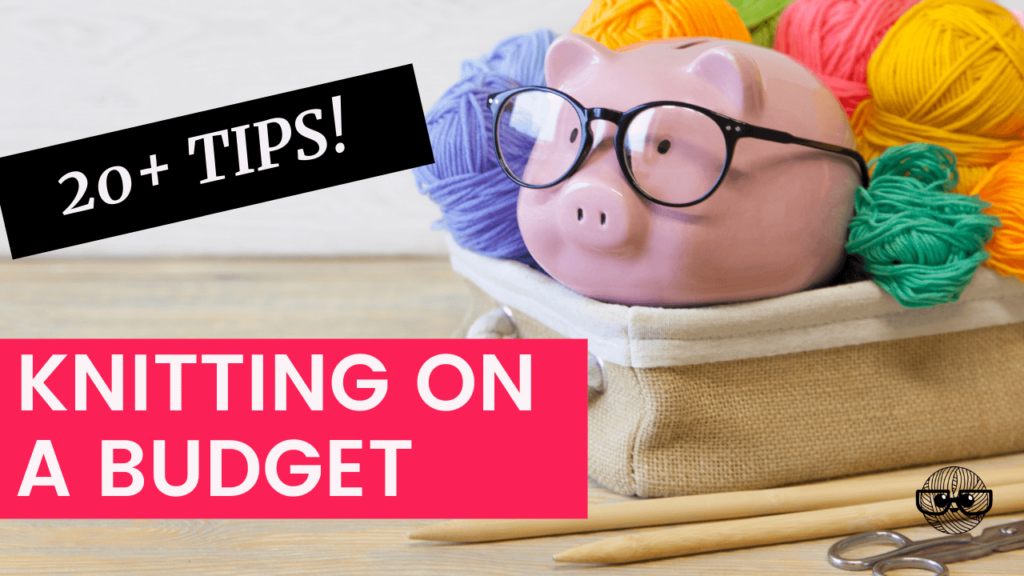Knitting can be an expensive hobby when you buy luxury yarn. But, it’s possible to save money and still enjoy your knitting. These money-saving tips for knitting on a budget will help knitters of all income levels find ways to save more, spend less, and be more mindful of their knitting projects and adventures.
The one thing to remember is that it doesn’t matter what yarn you use, which designers you love to follow – it all comes down to your own knowledge and knitting experience. That knowledge and experience give you creative freedom as you understand how to change and modify any project and pattern. It’s all about mindset – learn to be resourceful (and not resentful).
The 20+ tips below are divided into sections to make finding relevant money-saving tips easier to find.
Some links below are affiliate links. If you click through and make a purchase I may receive a small commission at no extra charge to you. See the disclosure policy for more information.
Saving Money on Knitting Needles & Notions
Use thrift stores to try out different types of needles
Before splurging on a large set of needles, it’s important to try out different materials to see what you like to use. I love the look of those Lykke driftwood needles, but when I bought some wood needles to try them out I discovered how much I dislike wood needles. Thank goodness I learned that lesson before investing in a large interchangeable set.
Instead, head to the secondhand store and look for a variety of knitting needles in different materials to try out. As you use them you’ll be able to identify the materials and the types of needles you prefer.
And while you’re looking at the knitting needles at garage sales and secondhand stores, see what’s available for knitting notions – you’ll usually find lots of great finds like bobbins, counters, and cable needles (and yarn – but we’ll address that in the next section).
Invest in the right set of knitting needles
Once you’ve tried different knitting needle materials and you’ve discovered the kinds of needles you like, it’s really worth it to invest in a set of needles. You will save money in the long run! Instead of buying a random set here and there as you need them, you’ll save money by buying one complete set.
If you find that you knit most items flat and don’t mind seaming you can probably invest in a good set of straight needles with a few circulars for smaller circumference items (like hats or sleeves).
But, if you’re looking for workhorse knitting needles that will cover everything, a set of circular interchangeable needles is your best option (here are my recommendations and Favorite Knitting Needles). They can be used for knitting flat and for knitting in the round – so all your bases are covered. And, if you get a set with 4-inch needle tips you’ll be able to work 16-inch circumferences in the round as well.
Learn how to knit using magic-loop
Magic loop is a simple method of working small circumferences in the round using a long cable. Half the stitches are placed on one side and the other half of the stitches are placed along the other side. The long cable is used to give you room to maneuver as you knit across each set of stitches.
By combining this method with a set of interchangeable needles you’ll be able to work all your projects using one set of needles.
If you prefer a quick video, I demonstrate how to use the magic-loop method while working a swatch in this video:
Saving Money on Knitting Patterns
After a good set of needles (and buying yarn, of course), knitting patterns are something you’ll be buying regularly. Before I talk about all the ways to save money or find free patterns I just want to state that designers deserve the money they make from selling their patterns. So, when possible, purchase the pattern you’re interested in directly from the designer. Don’t try to work around copyright laws (and basic decency) by using pirated copies of a pattern.
If there is a particular designer that you love, join their email list. You’ll often get discount codes and sometimes free patterns. You’ll also be the first to know of test knitting calls or pattern discounts (which are both good ways to save some money).
Physical Patterns
The public library is a great option for books of patterns and knitting techniques. If your local library doesn’t offer many choices, look at nearby towns and cities. I actually pay a yearly membership to a large city nearby so I can have access to their wonderful library system. The membership more than pays for itself over the course of a year.
Look at thrift stores and garage sales for knitting books. They are often a treasure-trove of old patterns and books.
Digital Patterns
The age of the internet has changed the knitting world and opened up a whole new avenue for knitters. You can find all the techniques, tutorials, and patterns you want online.
Besides Ravelry, you can find free patterns in many places:
- Knitty
- Lovecrafts
- Yarn company websites all have free patterns that feature their yarns – Yarnspirations (which features patterns using Bernat, Red Heart, and Caron), free patterns at Rowan, Lion Brand Yarns, and Drops Design, to name just a few of the available websites with free patterns.
- Digital apps – check your library to see if they offer access to things like Overdrive or RB Digital
If you like old (and vintage) patterns and books there are even more options available online:
Learn to design your own sweaters
Now you don’t need to become a full-fledged designer, but with two good reference books, you can create truly unique sweaters. First, you’ll want a book like Amy Herzog’s Ultimate Sweater Book (available at Amazon) which explains basic sweater construction for a variety of sweater shapes and has all the numbers and math figured out for you.
Combine a basic sweater construction book with a stitch dictionary, like Barbara Walker’s Treasury of Knitting Patterns (available at Amazon) and you can design your own personalized sweaters.
Discover the Confidence You Need to Fix Your Knitting Mistakes

By the end of this six-part self-paced course, you’ll be able to read your knitting, recognize a variety of knitting mistakes, and understand how to fix them.
Saving Money on Yarn
The largest ongoing expense in knitting is purchasing yarn. And, while many patterns use high-end luxury yarn, that doesn’t mean you have to! It’s easy to substitute and use a different yarn in any knitting pattern.
Yarn substitution
Learning how to substitute yarns in knitting patterns is an essential skill for every knitter to have. There is no reason to depend on designers and other knitters to tell you what yarn you need to use. It just takes a few simple steps to find a proper substitute yarn.
Find the key things you need to know in this article: A Beginner’s Guide to Yarn Substitution
If you want something even easier, take a look at Yarn Sub. Just type in the name of the yarn used in the pattern and the website will provide a list of suitable alternative yarns. But take a little time to study the substitutes and determine why they were chosen as possible replacements.
Yarn substitution is a vital skill for any successful knitter. There is no reason a competent knitter can’t learn how to substitute yarns.
Recycle & upcycle
Secondhand stores are a treasure trove of yarn. You can usually find bins filled with yarn. While plenty of it is cheap acrylic, by sorting through you can sometimes find a worthwhile treasure (I’ve found 100% merino and various alpaca yarns when I’ve taken time to search).
You can also recycle actual sweaters. Look for sweaters knit with natural fibers and crocheted seams (you can search YouTube for tips on how to recycle sweaters for their yarn). The seams are an important part – machine-knit sweaters that are cut and sewn are not good for recycling. But machine-knit sweaters with crochet-like seams can be taken apart and each of the pieces can be unraveled for their yarn.
And don’t forget about your own unused project. Frog your unused projects and reuse the yarn; I’ve even frogged full sweaters I don’t wear anymore and reuse the yarn for something new.
Keep your small bits of yarn and look for patterns that will use those leftovers (log cabin blankets, mitered square blankets, etc). And a bonus tip: keep yarns of the same weight and general fiber content (animal or plant) in separate bags so when you find a suitable project you’ll have the scrap yarn ready to go.
And, for those really short lengths of yarn that you can’t bear to throw away, make a magic-knotted ball, splicing the yarns together to create your own ‘scrappy’ ball of yarn.
If you’re feeling especially crafty (or crazy!), you can make your own yarn from old t-shirts and even plastic bags. Both would make great market bags and rugs.
Shopping for yarn
At big-box stores, you can save money on yarn too. Many craft stores have coupons and sales. You can also look for large bags of mill end yarns (it’s a good way to get some wool yarn a little more cheaply).
And, when possible, support your local yarn shop. Sometimes you’ll find sale bins or there may be special sales throughout the year (I like to save up birthday money for some special splurges at my local yarn shop). If your local yarn shop always has big sales at certain times you can plan your purchases and save up for those occasions.
When you are looking to splurge, remember that yarn is sold by weight so thinner yarns (like fingering weight) will have more yardage to a skein than something like a bulky yarn. Both might be sold in 50 or 100-gram put-ups but 100-grams of fingering weight yarn will have much more yardage than a 100-gram skein of bulky yarn.
If there is an online yarn brand/line that you like, see if they have a color card or palette so you aren’t making disappointing purchases because the color isn’t what you expected. It’s an extra expense but it will pay for itself. There’s nothing worse than purchasing a sweater quantity of yarn only to find out the color isn’t what you expected.
Spin & dye your own yarn
If you’re feeling adventurous, dyeing yarn is a fun project (I’ve used food coloring and Kool-aid to dye my own yarn a few times – and it’s lots of fun). You can find yarn ready to dye at Knit Picks and try your own dyeing adventures. I found ChemKnits on YouTube to be a valuable resource for learning how to dye yarn with food-grade dyes. Since it’s only food coloring there’s no special equipment needed – you can use the pots and pans in your kitchen.
If you’re even more adventurous, a pound of undyed fiber costs much less than a hand-dyed skein from an independent dyer. That fiber and a drop spindle might open up a whole new fiber-world for you.
Change your mindset
In all of these money-saving tips, it’s important to consider your mindset. We all have financial boundaries and make choices every day about how we spend our money. Instead of feeling resentful that you can’t afford that expensive, indie-dyed yarn, be glad that you have the mental capacity to be resourceful and make choices that will still make you happy (and save you some money).
More Budget-Friendly Knitting Advice
- 20 Fun Stash Busting Blanket Knitting Patterns
- 12 Affordable (100% Wool) Yarns for Knitters
- 12 Affordable Sock Yarns for Knitting
